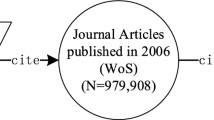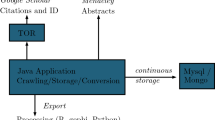Abstract
This study explores the characteristics of scientific activity patterns through co-author affiliations to obtain new insights into interdisciplinary research. To classify the interdisciplinarity in research, we explored and compared two different approaches: the diversity of disciplines reflected in the listed affiliations of the authors and the diversity of the subject categories reflected in the reference list. To assess the diversity in departmental affiliations, we developed an explorative methodology that retrieves feature words from a combination of manual work and the thesaurus function in the Thomson Data Analyzer text mining tool. To assess the diversity in references, we followed the conventional approach applied in previous work. With both approaches, we relied on diversity as the measure for assessing interdisciplinarity of 157,710 articles published in PloS One (2007–2016). Based on a comparison between the results of both approaches, our study confirms that different methodologies and indicators can produce seriously inconsistent, and even contradictory results. In addition, different indicators may capture different understandings of such a multi-faceted concept as interdisciplinarity. Our results are summarized in a schematic representation of this twofold perspective as a method of indexing the different types of interdisciplinarity commonly found in research studies.




Similar content being viewed by others
Notes
For example, at the level of consolidated scientific research programmes, US science and technology funding agencies are increasingly supporting large-scale, centralized, grant-based research projects that span multiple disciplines and institutions (Corley et al. 2006). European programs are promoting collaboration and creating regional and international scientific networks of different generations of researchers to spread skills (European Commission 2012). Further, leading research institutes are demanding innovative solutions that combine knowledge from different scientific disciplines (National Academies 2004).
In the following part, affiliation(s) always refers to the departmental affiliation(s) listed by an author.
The cross-citation matrix of all SCs (1991–2015) was constructed by Lin Zhang based on an in-house database of the Centre for R&D Monitoring (ECOOM), Belgium.
Some experiments were tried before we set the threshold of 60%. Compared to other thresholds, for instances, 70% or 80%, the threshold of 60% provides a much more balanced distribution of publications among the three sub-datasets.
References
Abramo, G., D’Angelo, C. A., & Costa, F. D. (2012). Identifying interdisciplinarity through the disciplinary classification of coauthors of scientific publications. Journal of the Association for Information Science & Technology, 63(11), 2206–2222.
Abramo, G., D’Angelo, C. A., & Di Costa, F. (2017). Do interdisciplinary research teams deliver higher gains to science? Scientometrics, 111(1), 317–336.
Abramo, G., D’Angelo, C. A., & Zhang, L. (2018). A comparison of two approaches for measuring interdisciplinary research output: The disciplinary diversity of authors vs the disciplinary diversity of the reference list. Journal of Informetrics. (under review).
Adams, J., Loach, T., & Szomszor, M. (2016). Interdisciplinary research: Methodologies for identification and assessment. Digital Research Reports. London: Digital Science.
Choi, B. C., & Pak, A. W. (2006). Multidisciplinarity, interdisciplinarity and transdisciplinarity in health research, services, education and policy: 1. Definitions, objectives, and evidence of effectiveness. Clinical and Investigative Medicine. Medecine Clinique et Experimentale, 29(6), 351–364.
Corley, E. A., Boardman, P. C., & Bozeman, B. (2006). Design and the management of multi-institutional research collaborations: Theoretical implications from two case studies. Research Policy, 35(7), 975–993.
Dogan, M., & Pahre, R. (1990). Creative marginality: Innovation at the intersections of social sciences. Boulder: Westview Press.
European Commission. (2012). Enhancing and focusing EU international cooperation in research and innovation: A strategic approach. Brussels, COM (2012) 497 final. Retrieved April 24, 2018, from http://ec.europa.eu/research/iscp/pdf/policy/com_2012_497_communication_from_commission_to_inst_en.pdf#view=fit&pagemode=none.
Garfield, E., Malin, M., & Small, H. (1978). Citation data as science indicators. In Y. Elkana, J. Lederberg, R. K. Merton, A. Thackray, & H. Zuckerman (Eds.), Toward a metric of science: The advent of science indicators (pp. 179–208). New York: Wiley.
Glänzel, W., & Schubert, A. (2003). A new classification scheme of science fields and subfields designed for scientometric evaluation purposes. Scientometrics, 56(3), 357–367.
Hu, M., Li, W., Li, L., Houston, D., & Wu, J. (2016). Refining time-activity classification of human subjects using the global positioning system. PLoS ONE, 11(2), e0148875.
Huang, Y., Zhang, Y., Youtie, J., Porter, A. L., & Wang, X. (2016). How does national scientific funding support emerging interdisciplinary research: A comparison study of big data research in the US and China. PLoS ONE, 11(5), e0154509.
Huutoniemi, K., Klein, J. T., Bruun, H., & Hukkinen, J. (2010). Analyzing interdisciplinarity: Typology and indicators. Research Policy, 39(1), 79–88.
Jost, L. (2009). Mismeasuring biological diversity: Response to Hoffmann and Hoffmann (2008). Ecological Economics, 68(4), 925–928.
Klein, J. T. (2008). Evaluation of interdisciplinary and transdisciplinary research: A literature review. American Journal of Preventive Medicine, 35(2), 116–123.
Larivière, V., & Gingras, Y. (2010). On the relationship between interdisciplinarity and scientific impact. Journal of the Association for Information Science and Technology, 61(1), 126–131.
Ledford, H. (2015). How to solve the world’s biggest problems. Nature, 525(7569), 308–311.
Leinster, T., & Cobbold, C. A. (2012). Measuring diversity: The importance of species similarity. Ecology, 93(3), 477–489.
Leydesdorff, L., & Rafols, I. (2011). Indicators of the interdisciplinarity of journals: Diversity, centrality, and citations. Journal of Informetrics, 5(1), 87–100.
Leydesdorff, L., Wagner, C. S., & Bornmann, L. (2018). Betweenness and diversity in journal citation networks as measures of interdisciplinarity—A tribute to Eugene Garfield. Scientometrics, 114(2), 567–592.
Maas, F., Spoorenberg, A., Brouwer, E., Bos, R., Efde, M., Chaudhry, R. N., et al. (2015). Spinal radiographic progression in patients with ankylosing spondylitis treated with TNF-alpha blocking therapy: A prospective longitudinal observational cohort study. PLoS ONE, 10(4), e0122693.
Morillo, F., Bordons, M., & Gómez, I. (2003). Interdisciplinarity in science: A tentative typology of disciplines and research areas. Journal of the American Society for Information Science and Technology, 54(13), 1237–1249.
Mugabushaka, A. M., Kyriakou, A., & Papazoglou, T. (2016). Bibliometric indicators of interdisciplinarity: the potential of the Leinster–Cobbold diversity indices to study disciplinary diversity. Scientometrics, 107(2), 593–607.
National Academies Committee on Facilitating Interdisciplinary Research, Committee on Science, Engineering and Public Policy. (2004). Facilitating interdisciplinary research. Washington, DC: National Academies Press.
National Science Foundation. (2004). Retrieved April 26, 2018, from https://www.nsf.gov/od/oia/additional_resources/interdisciplinary_research/definition.jsp.
Nijssen, D., Rousseau, R., & Hecke, P. V. (1998). The Lorenz curve: A graphical representation of evenness. Coenoses, 13(1), 33–38.
Porter, A. L., Cohen, A. S., Roessner, J. D., & Perreault, M. (2007). Measuring researcher interdisciplinarity. Scientometrics, 72(1), 117–147.
Porter, A. L., & Rafols, I. (2009). Is science becoming more interdisciplinary? Measuring and mapping six research fields over time. Scientometrics, 81(3), 719–745.
Porter, A. L., Roessner, D. J., & Heberger, A. E. (2008). How interdisciplinary is a given body of research? Research Evaluation, 17(4), 273–282.
Rafols, I., & Meyer, M. (2010). Diversity and network coherence as indicators of interdisciplinarity: Case studies in bionanoscience. Scientometrics, 82(2), 263–287.
Rao, C. R. (1982). Diversity and dissimilarity coefficients: A unified approach. Theoretical Population Biology, 21(1), 24–43.
Rijnsoever, F. J. V., & Hessels, L. K. (2011). Factors associated with disciplinary and interdisciplinary research collaboration. Research Policy, 40(3), 463–472.
Rinia, E. J., Leeuwen, T. N. V., & Raan, A. F. J. V. (2002). Impact measures of interdisciplinary research in physics. Scientometrics, 53(2), 241–248.
Rousseau, R., Zhang, L., & Hu, X. J. (2018). Knowledge Integration: Its meaning and measurement. In W. Glänzel, H. Moed, U. Schmoch, & M. Thelwall (Eds.), Springer handbook of science and technology indicators. Berlin: Springer.
Schmickl, C., & Kieser, A. (2008). How much do specialists have to learn from each other when they jointly develop radical product innovations? Research Policy, 37(3), 473–491.
Schummer, J. (2004). Multidisciplinarity, interdisciplinarity, and patterns of research collaboration in nanoscience and nanotechnology. Scientometrics, 59(3), 425–465.
Stirling, A. (2007). A general framework for analysing diversity in science, technology and society. Journal of the Royal Society, Interface, 4(15), 707.
Stokols, D., Fuqua, J., Gress, J., Harvey, R., Phillips, K., Baezconde-Garbanati, L., et al. (2003). Evaluating transdisciplinary science. Nicotine & Tobacco Research, 5(Suppl_1), S21–S39.
Sumra, M. K., & Schillaci, M. A. (2015). Stress and the multiple-role woman: Taking a closer look at the “Superwoman”. PLoS ONE, 10(3), e0120952.
Suresh, S. (2012). Global challenges need global solutions. Nature, 490, 337–338.
Sutherland, W. J., Bellingan, L., Bellingham, J. R., Blackstock, J. J., Bloomfield, R. M., Bravo, M., et al. (2012). A collaboratively-derived science-policy research agenda. PLoS ONE, 7(3), e31824.
Wagner, C. S., Roessner, J. D., Bobb, K., Klein, J. T., Boyack, K. W., Keyton, J., et al. (2011). Approaches to understanding and measuring interdisciplinary scientific research (IDR): A review of the literature. Journal of Informetrics, 5(1), 14–26.
Wang, J., & Shapira, P. (2015). Is there a relationship between research sponsorship and publication impact? An analysis of funding acknowledgments in nanotechnology papers. PLoS ONE, 10(2), 555–582.
Wang, J., Thijs, B., & Glänzel, W. (2015). Interdisciplinarity and impact: Distinct effects of variety, balance, and disparity. PLoS ONE, 10(5), e0127298.
Zhang, L., Rousseau, R., & Glänzel, W. (2016). Diversity of references as an indicator of the interdisciplinarity of journals: Taking similarity between subject fields into account. Journal of the Association for Information Science and Technology, 67(5), 1257–1265.
Zhang, L., Sun, B., & Huang, Y. (2018). Interdisciplinarity measurement based on interdisciplinary collaborations: A case study on highly cited researchers of ESI social sciences. Journal of the China Society for Scientific and Technical Information, in Chinese, 37(3), 231–242.
Zhang, L., Sun, B., Huang, Y., & Chen, L. X. (2017). Interdisciplinarity and collaboration: On the relationship between disciplinary diversity in the references and in the departmental affiliations. In Proceedings of ISSI 2017—The 16th international conference on scientometrics and informetrics (pp. 1064–1075). Wuhan University, China.
Zhou, L., Liu, L., Liu, X., Chen, P., Liu, L., Zhang, Y., et al. (2014). Systematic review and meta-analysis of the clinical efficacy and adverse effects of Chinese herbal decoction for the treatment of gout. PLoS ONE, 9(1), e85008.
Acknowledgements
The present study is an extended version of an article presented at the 16th International Conference on Scientometrics and Informetrics, Wuhan (China), 16–20 October 2017 (Zhang et al. 2017). The authors would like to acknowledge support from the National Natural Science Foundation of China (Grant No. 71573085), the Innovation Talents of Science and Technology in HeNan Province (Grant Nos. 16HASTIT038, 2015GGJS-108), and the Excellent Scholarship in Social Science in HeNan Province (No. 2018-YXXZ-10). We thank Giovanni Abramo and Ronald Rousseau for inspiring discussions.
Author information
Authors and Affiliations
Corresponding authors
Rights and permissions
About this article
Cite this article
Zhang, L., Sun, B., Chinchilla-Rodríguez, Z. et al. Interdisciplinarity and collaboration: on the relationship between disciplinary diversity in departmental affiliations and reference lists. Scientometrics 117, 271–291 (2018). https://doi.org/10.1007/s11192-018-2853-0
Received:
Published:
Issue Date:
DOI: https://doi.org/10.1007/s11192-018-2853-0




